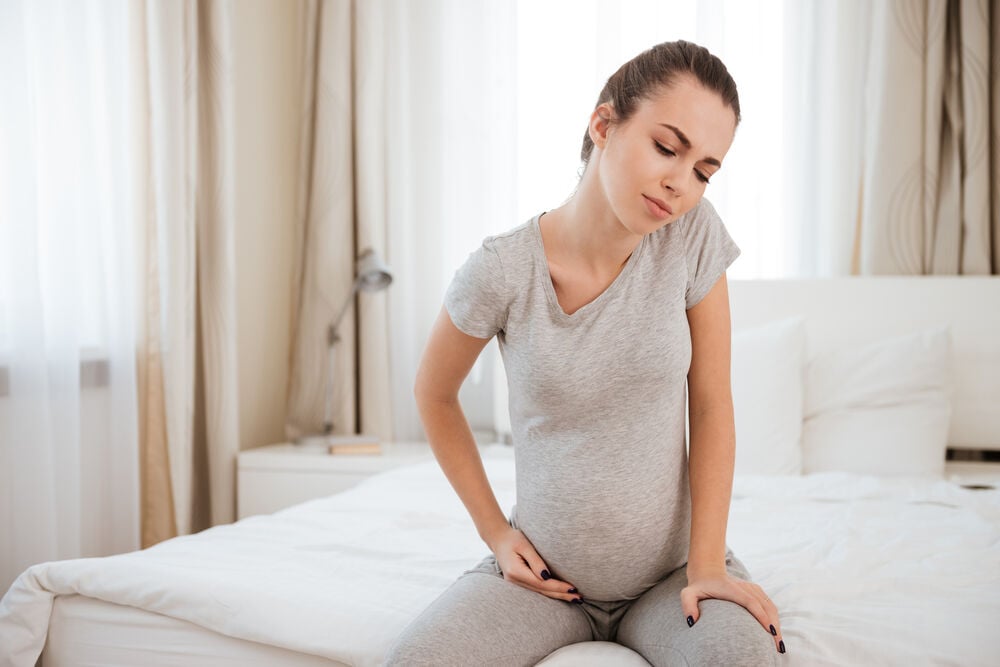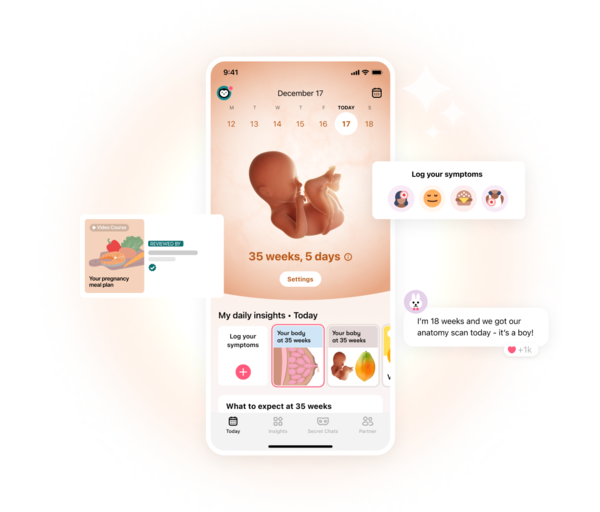It can be hard to discern ovary pain from other kinds of abdominal discomfort during pregnancy, especially if it’s your first time. So we’ll explain how to tell the difference, how it affects your overall health, and what to do about it.
-
Tracking cycle
-
Getting pregnant
-
Pregnancy
-
Help Center
-
Flo for Partners
-
Anonymous Mode
-
Flo app reviews
-
Flo Premium New
-
Secret Chats New
-
Symptom Checker New
-
Your cycle
-
Health 360°
-
Getting pregnant
-
Pregnancy
-
Being a mom
-
LGBTQ+
-
Quizzes
-
Ovulation calculator
-
hCG calculator
-
Pregnancy test calculator
-
Menstrual cycle calculator
-
Period calculator
-
Implantation calculator
-
Pregnancy weeks to months calculator
-
Pregnancy due date calculator
-
IVF and FET due date calculator
-
Due date calculator by ultrasound
-
Medical Affairs
-
Science & Research
-
Pass It On Project New
-
Privacy Portal
-
Press Center
-
Flo Accuracy
-
Careers
-
Contact Us
Ovary Pain During Pregnancy: What Does It Mean?


Every piece of content at Flo Health adheres to the highest editorial standards for language, style, and medical accuracy. To learn what we do to deliver the best health and lifestyle insights to you, check out our content review principles.
Causes of ovary pain during pregnancy
The reasons behind ovary pain during pregnancy range from relatively harmless to more serious conditions that require immediate attention. A sharp, stabbing pain in your left or right side or a dull, throbbing pain that doesn’t go away should be discussed with your ob-gyn.
Take a quiz
Find out what you can do with our Health Assistant
Ovary pain during pregnancy can be attributed to a number of things:
Expanding uterus
As your uterus expands to accommodate your baby, it presses against your ovaries. Hormonal changes also cause pain in the round ligaments along either side of your abdomen. This, in turn, puts a dull sensation of pressure on your ovaries. An expanding uterus can also cause overall pelvic and vaginal pain.
Endometriosis
Ordinarily, your uterus produces a lining of blood and mucus for a fertilized egg to implant itself. For those with endometriosis, however, this lining grows outside the uterus. It’s a painful condition that occurs monthly.
Painful periods or intercourse, heavy flow, and infertility are all symptoms of endometriosis. To diagnose this condition, your doctor will need to conduct an MRI or laparoscopic examination.
While periods are an opportunity for unused uterine tissues to exit the body through the vagina, endometrial buildup (foci) can’t leave the body. Scar tissue accumulates, leading to pain and swelling, especially around your ovaries.
Painful periods or intercourse, heavy flow, and infertility are all symptoms of endometriosis. To diagnose this condition, your doctor will need to conduct an MRI or laparoscopic examination.
Ovarian cyst

Cysts are small, fluid-filled sacs on the surface of your ovaries. They’re pretty common, particularly during your childbearing years. When an egg isn’t fully released, it doesn’t leave the sac and instead develops into a cyst.
Single cysts tend to go away on their own, without any noticeable pain. Occasionally, though, they’ll rupture and cause a mild, dull pain.
Cysts are pretty common, particularly during your childbearing years. When an egg isn’t fully released, it doesn’t leave the sac and instead develops into a cyst.
Discomfort due to intercourse or a bowel movement often indicates ovarian cysts. Nausea or vomiting, bloating, and a feeling of fullness after a light meal are further warning signs. If this happens, see your doctor for an ultrasound or pelvic exam.
A serious condition, known as polycystic ovarian syndrome (PCOS), disproportionately affects overweight or obese women. It’s a hormonal disorder which causes multiple ovarian cysts, excess testosterone production, possible infertility, and ovary pain.
Ovarian torsion or rupture
In rare instances, your ovaries may wrap themselves around your uterine tubes or blood vessels. This restricts blood flow and can rupture the ovaries or kill the eggs inside them.
Ovarian torsion often occurs during in vitro fertilization. Fertility drugs increase the number of eggs you have, which makes the ovaries heavy and swollen. Additionally, strenuous exercise such as heavy cardio, weight lifting, and abdominal crunches put you at greater risk for ovarian torsion.
Ovarian torsion often occurs during in vitro fertilization. Fertility drugs increase the number of eggs you have, which makes the ovaries heavy and swollen.
If left untreated, ovarian torsion may lead to ovarian rupture, which is extremely serious. Other triggers include a large ruptured cyst that damaged the ovaries (due to vigorous sexual activity, for example) or an ectopic pregnancy.
Ectopic pregnancy
An ectopic pregnancy occurs when the fertilized egg implants anywhere besides the uterus. If conception occurs early in your cycle and the egg hasn’t reached your uterus, the sperm fertilizes it farther up the uterine tubes. The egg then attaches inside the uterine tube, which is not equipped to accommodate a growing embryo.
Sometimes, ectopic pregnancies rupture the uterine tube, resulting in pain and vaginal bleeding. Bleeding is either lighter or heavier than typical menstrual flow, and has a different consistency. Ectopic pregnancy also causes lightheadedness, nausea, or dizziness. If you observe these symptoms, consult your doctor.
Early pregnancy loss
Early pregnancy loss is particularly common in the first trimester. You may feel ovary pain and notice severe cramping and bleeding during a miscarriage. Cramping indicates that your uterus is attempting to expel the miscarriage, and it places pressure on your ovaries in the process.
Fibroids
Fibroids are noncancerous growths in or around your uterus. These small, abnormal groups of cells aren’t life-threatening, but they can produce heavy, prolonged periods and lower back and ovary pain.
They also make it harder to conceive and trigger frequent urination (due to increased pressure on your bladder or pelvic floor).
Fibroids are noncancerous growths in or around your uterus. These small, abnormal groups of cells aren’t life-threatening, but they can produce heavy, prolonged periods and lower back and ovary pain.
Fibroids can be so small they’re only detectable with an ultrasound, or so large that they expand into your abdomen and create a distended belly. Larger masses often produce constant, dull ovary pain and might require surgery.
Placental abruption
The risk of placental abruption is highest towards the end of your pregnancy. This is when the placenta partially or fully separates from the uterine wall. This often causes sudden spotting or vaginal bleeding, depending on where the separation occurred and the severity of tearing. The pressure this puts on your ovaries also results in a sharp pain.
The risk of placental abruption is highest towards the end of your pregnancy. This is when the placenta partially or fully separates from the uterine wall.
Without the placenta intact, your baby won’t receive vital oxygen-rich blood and nutrients. Instead, blood pools inside your uterus, and unless it’s released through the vagina, it builds up a dangerous amount of pressure.
Seek immediate medical attention if you feel a pulling sensation, suddenly begin bleeding, or observe a swollen area on your baby bump.
Safe ways to treat ovary pain during pregnancy
Depending on the underlying cause, you might be able to treat ovary pain at home. Place a heating pad over the area where you’re feeling pain or soreness. Try to rest by sitting in a partially elevated position. Lying completely flat may actually pull or stretch your ovaries and other affected areas.

A warm (but not hot) shower or bath is another effective remedy. Consider wearing a pelvic support garment to hold your uterus in place, alleviating pressure on your abdominal wall and ovaries. Lastly, remember to check with your doctor before taking any OTC pain medications.
Does ovary pain signal implantation?
Once pregnant, you could notice cramping or dull pain in your uterus, breast soreness, and lightheadedness. However, some women say they actually experience ovary pain during the implantation process. If this is the case, see your doctor right away as it’s a possible indication of ectopic pregnancy.
When to see a doctor
If you’re pregnant or sexually active, you should never ignore a sharp, stabbing pain in either side of your abdomen. Ovary pain during pregnancy accompanied by cramps, bleeding, or dizziness requires immediate medical attention.


Hey, I'm Anique
I started using Flo app to track my period and ovulation because we wanted to have a baby.


The Flo app helped me learn about my body and spot ovulation signs during our conception journey.


I vividly
remember the day
that we switched
Flo into
Pregnancy Mode — it was
such a special
moment.
Real stories, real results
Learn how the Flo app became an amazing cheerleader for us on our conception journey.
References
History of updates
Current version (23 November 2021)
Published (27 September 2019)
In this article

Get your personal guide to pregnancy with the Flo app
-
Follow your baby's growth week by week
-
Get expert info on symptoms, safe foods, and more
-
Chat with other parents-to-be




